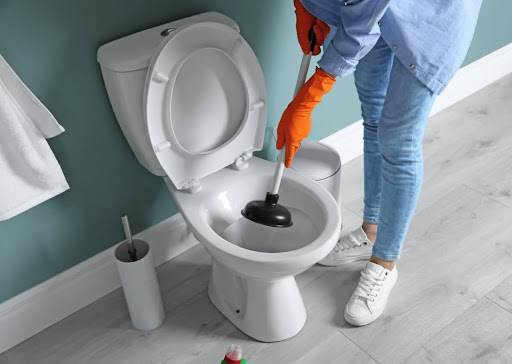At some point in our lives, we’ve all faced the dreaded reality of a clogged toilet. The immediate reaction often involves a mix of panic, disgust, and the urgent question, “Where’s the plunger?” Yet, despite its common presence in households, not everyone knows the dos and don’ts of using a plunger effectively. This essential tool can quickly become your best ally in combating clogged toilets, but only if wielded correctly.
In this blog, we’ll walk through the best practices, tips, and techniques for plunging a toilet like a pro. The next time you face a clog, you’ll be well-prepared to tackle it head-on.
What Makes a Plunger Effective?
Before diving into the specifics, it’s crucial to grasp what makes a plunger not just a piece of rubber on a stick but a vital household tool. Plungers work by creating a seal around the drain hole and using the force of air and water pushed through the pipes to dislodge clogs. The effectiveness of this process hinges on several key factors, including the type of plunger you’re using and how you apply force. For toilets, a flange plunger with an extended rubber flap provides a better seal and more targeted pressure, making it your best bet for most toilet clogs.
The Do’s of Using a Plunger
Plunging a toilet might seem straightforward, but achieving the desired result — clearing the clog without creating a mess — requires a bit of know-how. Let’s go over some of the most effective tips for plunging a toilet.
Choose the Right Plunger
Not all plungers are created equal. For toilets, the aforementioned flange plunger is designed to fit snugly in the toilet drain, creating a tight seal necessary for effective plunging. For sinks and showers, a cup plunger is more appropriate, as its flat bottom is ideal for sealing against flat surfaces. If the clog is too stubborn for a plunger, a toilet auger can reach deeper and apply direct force to break up the blockage.
Prepare the Area and Yourself
To avoid turning a minor inconvenience into a major mess, take a few preparatory steps before you start plunging. Lay towels around the base of the toilet or bathroom sink to catch any spills. Wearing rubber gloves can protect your hands from bacteria and grime. If the toilet bowl is filled to the brim, remove some water to prevent an overflowing toilet, but make sure there’s enough water to cover the plunger head to create an effective seal.
Before plunging, also consider pouring hot water into the toilet bowl. This can help break down organic matter and make the plunging more effective.
The Plunging Technique
For a successful plunging session, angle the plunger so the cup is filled with as much water as possible. Next, start applying more water pressure and less air pressure; this approach is known to be effective for clearing clogs. Gently press down to expel the air trapped inside the plunger cup, then use forceful, consistent thrusts to dislodge the clog. It may take several attempts, but patience and persistence are key.
The Don’ts of Using a Plunger
The prospect of tackling a toilet clog is hardly appealing to anyone, prompting a universal desire to resolve such issues swiftly and with minimal fuss. Yet, employing the correct method is crucial; failure to do so can escalate the problem. As we’ve previously explored the correct approach for how to plunge a toilet, let’s now focus on the pitfalls to avoid.
Don’t Use Excessive Force
Applying too much force right away can cause the water you’re trying to push through the drain to splash back up, creating a mess and potentially spreading germs. Start gently to guarantee the seal is intact before increasing pressure.
Avoid Chemical Drain Openers Before Plunging
If you’ve already tried a chemical drain cleaner, plunging afterward can cause the chemicals to splash back on you, which is dangerous. It’s better to try plunging first or avoid chemicals altogether.
Don’t Give Up Too Quickly
Most toilet clogs and blockages in sinks can be resolved with a plunger if you use the correct technique and a bit of elbow grease. However, if the clog persists after several attempts, it may be time to try a different approach or call in the professionals.
When to Seek Help From a Professional Plumber
The dos and don’ts of using a plunger are fundamental to managing the most toilet clogs and ensuring your plumbing system operates smoothly. Armed with the right plunger and a proper technique, you can tackle most minor plumbing issues with confidence.
However, there are some situations where a plunger just won’t cut it. If you’re facing a stubborn clog that won’t budge or if you suspect there may be a deeper issue with your plumbing system, it’s time to call in the experts. At Pure Plumbing, we can handle even the most stubborn clogs efficiently and effectively. For emergencies that can’t wait, our team of emergency plumbers in Dallas is on standby to provide swift, reliable service.
Maintaining Your Plumbing System
The key to avoiding plumbing emergencies lies in regular maintenance and a proactive approach to care for your pipes, drains, and fixtures. Now that you know the dos and don’ts of using a plunger, let’s go one step further. Here are some tips to keep your plumbing system in top condition:
- Regular Inspections: Schedule annual inspections with a professional plumber to catch potential issues before they escalate into major problems.
- Be Mindful of What Goes Down Your Drains: To prevent clogs, be cautious about what you flush down your toilets or pour down your sinks. Avoid disposing of grease, food scraps, and non-biodegradable items in your drains. Only toilet paper and waste should go down your toilet.
- Use Strainers: Placing strainers over your drains in showers, tubs, and sinks can catch hair and debris, preventing them from causing blockages.
How to Keeping Your Entire Toilet Sparkling
While it’s important to know the best tips for plunging a toilet, maintaining a clean and hygienic toilet requires attention to detail and the right tools. For instance, the toilet brush is an indispensable tool for maintaining a clean toilet. Its design allows for scrubbing under the rim and deep into the bowl, areas where bacteria and stains can accumulate.
Start by applying a toilet cleaner or a mixture of vinegar and baking soda around the rim and sides of the bowl. Let it sit for a few minutes to break down stains and bacteria. Then, scrub thoroughly with the toilet brush, paying extra attention to under the rim and at the back of the bowl where water flows into the toilet.
Clogged Toilet? Contact Our Plumbing Experts Today!
Applying these tips for plunging a toilet can save you from potential plumbing disasters. However, it’s also important to recognize when a problem is beyond a DIY fix. Whether you’re dealing with a simple clog or a complex plumbing issue, remember that Pure Plumbing is here to help.
Don’t spend your day battling a clogged toilet. If you’ve tried all the tips but are still facing issues, contact Pure Plumbing today. Our team is ready to provide the effective, reliable services you deserve, including drain cleaning in Dallas, TX, or one of the surrounding areas.
If you’re facing a serious issue that requires immediate assistance, remember our emergency plumbers in Dallas are also available 24/7. We’re here to bring comfort back to your home. Contact us today!


